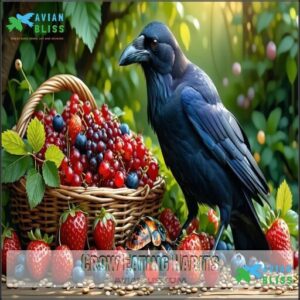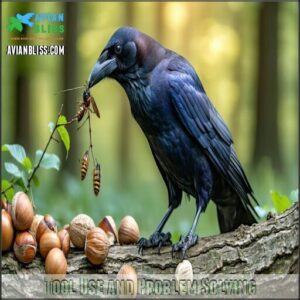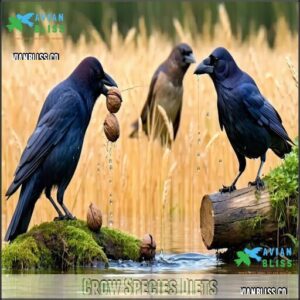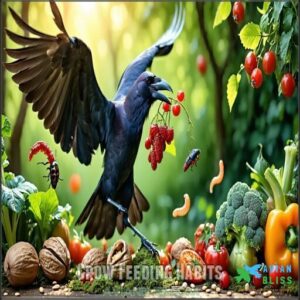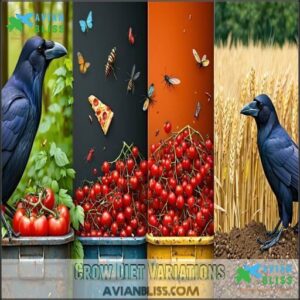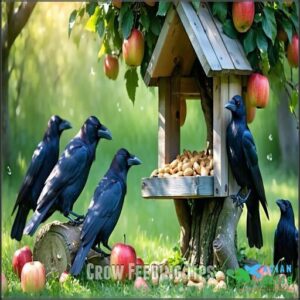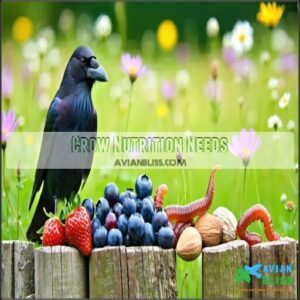This site is supported by our readers. We may earn a commission, at no cost to you, if you purchase through links.

They’ll also scavenge leftover food from humans, like bread, meat, or even fast-food fries. Crows are clever foragers and can use tools or solve problems to access food.
They adapt easily to cities or rural areas, so their diet varies based on what’s available. In urban settings, they might raid garbage bins, while in the wild, they feast on berries or worms.
Curious about their favorite snacks or what not to feed them? There’s more to discover about these smart birds!
Table Of Contents
- Key Takeaways
- Crow Eating Habits
- What Do Crows Eat
- Crow Food Sources
- Crow Foraging Habits
- Crow Species Diets
- Crow Feeding Habits
- Crow Favorite Foods
- Crow Diet Variations
- Crow Feeding Tips
- Crow Nutrition Needs
- Frequently Asked Questions (FAQs)
- Where did the phrase "eat crow" come from?
- What does it mean to "eat crow"?
- Is it still legal to hunt and eat crow in some states?
- What do crows typically eat?
- How Often Do Crows Eat or Should I Feed My Crows?
- Is it illegal to feed crows?
- Do crows eat other birds?
- What to feed crows?
- What do black crows eat?
- What are crows favorite food?
- Conclusion
Key Takeaways
- Crows eat a variety of foods, including seeds, nuts, fruits, insects, small animals, and human leftovers like garbage or fast food scraps.
- They’re opportunistic feeders, adapting their diet to what’s available, whether in cities, forests, or coastal areas.
- These clever birds use tools to access food and adjust their eating habits seasonally for nutritional balance.
- Avoid feeding crows processed, salty, or spoiled foods; instead, offer unsalted nuts, seeds, fruits, or protein-rich snacks like mealworms.
Crow Eating Habits
Crows eat a wide variety of foods, making them true opportunists. Their diet includes seeds, fruits, insects, small animals, and even human food scraps.
Omnivorous Diet
Crows are true omnivores, thriving on almost anything.
Crows are ingenious omnivores, thriving on their unmatched ability to adapt and forage for almost anything around them.
Their dietary adaptations include a mix of plant and animal matter, suited to what’s available. Scavenging behavior helps them secure food with ease. To maintain nutritional balance, they adjust seasonally, staying versatile.
- ● Crows eat seeds, berries, and grains.
- ● They consume insects, carrion, and small animals.
- ● Urban crows often rely on garbage.
Varied Food Sources
You’ll find crows eating everything from seeds to carrion, thanks to their incredible dietary adaptations.
Their scavenging behavior is shaped by food preferences and seasonal availability.
What crows eat often depends on what’s around—nuts, insects, small animals, or human leftovers. They prioritize nutritional content, exploring varied crow food sources through clever crow feeding habits that reflect unmatched foraging skills.
Adaptation to Environments
Adaptation is the crow’s superpower. Their dietary plasticity lets them thrive anywhere. Crows eat in cities, forests, or coastlines, adjusting to available crow food sources.
Adaptable and resourceful, crows thrive everywhere by embracing diverse diets, from city leftovers to forest berries and coastal seafood.
Crows exhibit self-control and foraging flexibility when adapting to new food sources.
- Urban crow diets often include garbage and scraps.
- Seasonal food shifts affect what crows eat.
- Resourceful foraging means finding carrion or berries.
- Habitat food impact shapes their diet.
- Omnivorous habits provide flexibility.
This structure allows crows to have a dietary plasticity that is essential for their survival in various environments.
What Do Crows Eat
Regarding the question of "what do crows eat," their diet is impressively varied.
These resourceful birds eat insects, seeds, fruits, vegetables, nuts, eggs, and even small mammals.
Their scavenging skills lead them to enjoy carrion consumption and human garbage.
Thanks to their dietary adaptations, they can thrive in wild and urban areas alike.
Food storage is another clever habit—crows hide meals for later use.
Foraging strategies include turning over leaves, digging, and even dropping nuts onto roads to crack them.
Remarkably, a crow diet adjusts seasonally, helping them avoid nutritional deficiencies.
| Category | Examples | Purpose |
|---|---|---|
| Plant Matter | Seeds, fruits, grains | Energy and nutrients |
| Animal Protein | Insects, mice, frogs | Growth and repair |
| Carrion | Roadkill, dead fish | Scavenging ease |
| Human Food | Garbage, bread, leftovers | Easy access |
| Stored Food | Buried seeds, food reserves | Backup in scarce times |
Crow Food Sources
Crows find food from various sources, including nature and human environments. They rely on their intelligence and adaptability to locate seeds, insects, fruits, and even garbage.
Seeds and Nuts
You might notice how seeds and nuts shape the crow diet. These snacks pack excellent nutritional value and fit their foraging techniques perfectly.
It’s interesting to note the variety of snacks they prefer, including:
- Sunflower seeds and pumpkin seeds
- Unsalted nuts like peanuts and almonds
- Acorns and walnuts
- Easily stored seeds for seasonal availability
- Cracked nuts dropped from heights
It’s interesting to note that you can find products for crows. It’s fascinating how crows eat and adapt to their environment, making them highly intelligent creatures.
Fruits and Berries
Crows love fruits and berries as part of their omnivorous diet.
Wild berries, like juniper and pokeberries, are seasonal treats, while orchard fruits, such as apples and grapes, add variety to their meals.
These foods offer great nutritional value.
However, toxic berries like holly can be dangerous.
Crows adapt their diet to what’s available, thriving across diverse habitats.
Insects and Worms
Crows love snacking on insects and worms, offering them valuable protein and energy.
Their varied crow diet includes many invertebrates, which they hunt with sharp attention. Bugs make easy and nutritious meals.
- Common prey: Caterpillars and grubs
- Spider predation: Preferred crunchy treat
- Worm digestion: Essential for survival
- Insect nutrition: Packed with energy
- Foraging skill: Exceptional ground hunters
Human Food and Garbage
Crows are urban scavengers, often drawn to garbage, trash bins, and dumpsters.
They’ll eat almost anything, from discarded snacks to human junk food. However, this dependence on food waste and trash can pose dietary risks and public health concerns.
While adaptable, crows need balance in their diet.
| Human Food Source | Attractiveness to Crows | Potential Risks |
|---|---|---|
| Chips and crackers | High | High salt, health issues |
| Bread and pasta | Moderate | Low nutrients |
| Rotten leftovers | High | Spoilage, bacteria |
This table highlights the potential risks associated with different human food sources that attract crows, emphasizing the need for a balanced diet to mitigate these risks.
Crow Foraging Habits
You’ll notice crows are expert foragers, always searching for food during the day.
They use their sharp beaks and clever problem-solving skills to uncover meals in natural and urban environments alike.
Daytime Food Gathering
When crows go food gathering, they stick to an efficient daytime routine.
Group foraging helps them spot opportunities quickly, while some use elevated perches for a bird’s-eye view.
Crow foraging often includes scavenging methods, like flipping leaves or searching underground sources for worms.
Their prey pursuit involves darting after insects or small animals—remarkable food gathering techniques for these omnivorous birds.
Tool Use and Problem Solving
Crows are clever creatures with astounding problem-solving skills.
Their tool-assisted foraging shows off their intelligence and cognitive abilities. You’ll notice their knack for innovation as they crack challenges like pros.
Here are examples of their tool use:
- Using sticks to extract insects.
- Dropping nuts on roads for cars to crack.
- Creating hooks from twigs.
- Lifting lids for food.
- Baiting fish with bread, showcasing their problem-solving skills.
Adapting to Human Environments
Clever and opportunistic, crows thrive in urban areas by relying on available human food sources.
They scavenge near dumpsters and parks, adapting quickly to suburban environments. Their diet often includes garbage consumption and scraps from feeding interactions.
These adaptable birds embrace human presence like seasoned survivalists, making the most of easily accessible meals. Crows’ impressive problem-solving abilities aid them in these foraging tasks.
| Behavior | Food Source | Adaptation | Location |
|---|---|---|---|
| Scavenging in garbage | Human food waste | Opportunistic feeders | Urban areas |
| Feeding interactions | Leftover scraps | Reliance on human food | Suburban settings |
| Park foraging | Discarded items | High adaptability | Public spaces |
| Roosting near homes | Kitchen scraps | Suburban adaptation | Residential spots |
Crow Species Diets
Each crow species has a unique diet based on its habitat and food availability. From insects and nuts to fish and carrion, they adapt to eat what’s around them.
American Crow Diet
The American crow thrives on an omnivorous diet shaped by regional variations and seasonal food availability.
These foraging strategies guarantee they adapt to changing environments and avoid nutritional deficiencies.
- Plant-Based Diet: Grains, nuts, fruits, and berries dominate.
- Animal Sources: Insects, mice, and roadkill feature prominently.
- Flexible Feeders: Garbage and leftover scraps highlight their adaptability.
Pied Crow Diet
Pied crows show incredible dietary adaptations influenced by habitat.
They thrive on seeds, nuts, fruits, and scavenged food like carrion. Their scavenging behavior includes garbage and leftover meals, revealing regional variations in their crow diet.
Insects, small lizards, and even bird eggs are favorites. Understanding what crows eat highlights their versatility and survival instincts across diverse habitats and conditions.
They’re also quite adaptable, thriving in Sub-Saharan Africa, which showcases their ability to live in various environments with diverse habitats.
Northwestern Crow Diet
Northwestern crows eat a mix of coastal food sources like shellfish, crustaceans, and carrion.
They’re clever foragers, often scavenging the intertidal zone diet by flipping rocks or wading into water for marine food.
Shellfish consumption is common, and they’ll drop hard-shelled prey to crack it.
These regional diet differences highlight their adaptability to aquatic food in coastal areas, showcasing their ability to thrive in various environments with coastal food sources.
Cape Crow Diet
Cape crows have a versatile diet. They forage for insects, seeds, fruits, and even bulbs, showing a unique bulb consumption habit.
With a special beetle preference, they also prey on chicks and depend on amphibians like frogs.
Seasonal variations in food availability influence their choices. Mainly ground foragers, Cape crows adapt their diet to what’s accessible, making their diet fascinating.
Fish Crow Diet
Fish crows are skilled hunters and scavengers, relying heavily on coastal food sources.
With a knack for saltwater adaptation, they thrive on fish, crabs, and shrimp from marine life.
Urban fish crows often scavenge garbage and carrion, adapting their crow diet to habitat changes.
This flexible diet showcases the variety in crow diet types, making them true survivalists with a flexible diet.
Crow Feeding Habits
Crows eat a wide variety of foods, from insects and seeds to small animals and human leftovers.
Their feeding habits are flexible and depend on what’s available in their surroundings.
Baby Crow Diet
Baby crows, or nestlings, depend entirely on their parents for food.
Adults feed them soft, protein-rich meals like insects and regurgitated pellets. This parental provisioning guarantees their nutritional needs are met during early growth stages.
As fledglings, they begin exploring what crows eat but still rely heavily on their parents. Their diet focuses on easy-to-digest foods essential for healthy development.
Adult Crow Diet
Adult crows have varied diets, shaped by dietary adaptations and their knack for finding food.
Their meals include seeds, nuts, insects, and even small animals, making their diet composition highly flexible.
In urban areas, they rely on scavenging human leftovers.
These foraging strategies guarantee they avoid nutritional deficiencies, which highlights their resourcefulness with seasonal foods and urban scavenging, showcasing their ability to adapt to different environments with a highly diverse diet breakdown.
Seasonal Variations
During summer abundance, crows feast on insects, fruits, and eggs, taking advantage of breeding season activity.
Fall foraging brings nuts and seeds to the forefront, preparing for winter scarcity.
Their winter diet shifts to scavenging carrion and stored food, showcasing impressive seasonal feeding adaptations.
Understanding migration timing is vital for crows to access the most abundant food sources.
Migration impact and omnivore habits support their crow diet variation, facilitating survival through changing environments.
Crow Favorite Foods
Crows eat a wide variety of foods based on what’s available in their environment. They especially love seeds, fruits, insects, and even small animals when the opportunity arises.
Seeds and Grains
Crows love seeds and grains, thanks to their nutritional value and availability in nature.
They snack on sunflower seeds, pumpkin seeds, corn, rice, and oats.
Their omnivorous nature helps with grain digestion, making these foods a key part of their diet.
Crows also assist in seed dispersal, though they’re known for causing crop damage while foraging.
Fruits and Vegetables
Crows enjoy a variety of fruits and vegetables, depending on seasonal availability.
Fruits like apples, grapes, and berries offer great nutritional value, while vegetables, including pumpkins and peppers, enrich their diet.
They often feast on preferred produce from gardens, causing crop damage.
To attract crows, scatter fresh, rinsed fruits or chopped vegetables.
Avoid processed foods and out-of-season items, as they do not provide the same nutritional benefits, and instead offer fresh alternatives.
Insects and Small Animals
Crows have diverse tastes, especially in the context of eating small creatures.
They’ll hunt or scavenge, showing their insect consumption and adaptability.
Their prey includes:
- Insects: Spiders, beetles, grasshoppers, and snails.
- Small Mammals: Mice, shrews, and young rabbits.
- Amphibian Prey: Frogs and salamanders.
- Reptile Diet: Lizards and small snakes.
Both live prey and carrion are fair game.
Crow Diet Variations
Crows adjust their diets based on what’s available in their surroundings, whether they’re in bustling cities or quiet rural areas.
Their food choices range from insects and fruits to garbage and small animals, depending on their habitat.
Regional Variations
Crows’ diets shift based on habitat influence and seasonal availability.
In coastal areas, fish and shellfish dominate, highlighting a unique coastal diet.
Meanwhile, American Crows favor grains and insects in farmland, while Pied Crows eat birds and reptiles in hotter regions.
The Northwestern Crow thrives on prey differences like crabs and carrion, showcasing incredible crow diet diversity across species and regions.
Urban Vs Rural Diets
Urban and rural crows have distinct diets shaped by food availability and habitat impact.
Urban areas provide processed human food, with garbage making up 65% of their diet.
Rural areas, however, offer more natural foods like nuts, insects, and small animals, improving nutritional differences.
Seasonal changes also affect crow diets, influencing foraging and scavenging behaviors in both environments.
Crow Feeding Tips
Feeding crows can be a rewarding experience if you know what to offer. Stick to healthy, natural foods like unsalted nuts, seeds, fruits, and small bits of meat.
What to Feed Crows
When feeding wild crows, choose foods that align with their nutritional needs.
Offer safe crow foods like:
- Unsalted nuts (peanuts or walnuts).
- Seeds (sunflower or pumpkin).
- Fruits (grapes or apples).
- Scraps (plain bread or rice).
- Insects (mealworms or crickets).
For ideal crow health, consider black oil sunflower seeds as a primary option.
Avoid harmful foods like salty snacks, processed meats, or chocolate to keep crows healthy.
How to Feed Crows
To feed crows, use safe foods like unsalted nuts or seeds.
Place small portions in open spaces or simple feeders. Avoid anything toxic or salty.
You can find various types of healthy nuts for crows online. Check local legal aspects and ethical considerations before starting.
Here’s a quick guide:
| Method | Benefits | Tips |
|---|---|---|
| Open trays | Easy access for crows | Keep food dry |
| Ground feeding | Attracts groups naturally | Use visible spots |
| Hanging feeders | Limits food thieves | Choose stable designs |
Feeding Frequency
How often should crows eat? It depends on their daily intake and feeding behavior.
Urban schedules and seasonal changes affect crow feeding patterns. Juvenile feeding needs are higher due to growth.
To keep them healthy, offer:
- Small portions in the morning and afternoon
- Consistent amounts that match their activity
- Scattered foods for natural foraging
- Seasonal variations to match their diet needs
Many people also look at the crow feeding products available.
Crow Nutrition Needs
Crows need a balanced diet rich in proteins, fats, and carbohydrates to stay healthy. Their food choices should also avoid harmful items like highly processed snacks or toxic substances.
Essential Nutrients
Crows thrive on a balanced diet that includes protein sources, healthy fat intake, and essential vitamins.
Hydration is also key to their well-being.
Here’s a quick breakdown:
| Nutrient | Source | Purpose |
|---|---|---|
| Protein | Insects, eggs, small mammals | Muscle growth, repair |
| Fats | Nuts, seeds | Energy, insulation |
| Vitamins & Minerals | Fruits, grains | Overall health, immune support |
Balanced crow diet composition guarantees thriving, adaptable birds!
Dietary Requirements
Understanding crow dietary requirements means focusing on nutrient balance, protein sources, and vitamin needs.
Their caloric intake varies by season, but protein is key for energy and growth. Essential nutrients include calcium and Vitamin D for bone health.
Here are the basics:
- Protein: Insects, eggs, and meat.
- Minerals: Seeds and nuts.
- Vitamins: Fruits.
- Energy: Grains.
Avoiding Harmful Foods
Too much junk food harms crows.
Processed foods, salty snacks, and pesticide exposure can weaken their health. Avoid onions, chocolate, and avocado—they’re toxic.
Spoiled food or seeds from apples may also pose risks. Even salt-heavy crumbs like chips should stay off their menu.
Stick to fresh, unseasoned options for a healthier crow diet. Stay cautious with what crows eat!
Frequently Asked Questions (FAQs)
Where did the phrase "eat crow" come from?
Imagine being forced to admit you were wrong.
"Eat crow" likely comes from an 1850s Southern U.S. tale where eating crow symbolized humiliation.
It’s now a phrase for swallowing pride and admitting mistakes, which can be seen as a form of humiliation.
What does it mean to "eat crow"?
To "eat crow" means admitting you’re wrong after confidently insisting otherwise.
It’s not pleasant, like swallowing your pride whole, but it shows humility and growth.
It’s about learning when to accept defeat gracefully.
Is it still legal to hunt and eat crow in some states?
Yes, hunting and eating crow is still legal in some states, though regulations vary.
You’ll need to check local hunting seasons and licenses.
Crows are often classified as migratory birds under U.S. law.
What do crows typically eat?
Crows thrive on variety, munching on seeds, nuts, fruits, insects, small animals, and even leftovers or garbage.
They’re smart scavengers, adapting their meals to whatever’s accessible—urban or wild, they’ll find something tasty anywhere, being resourceful in their search for food.
How Often Do Crows Eat or Should I Feed My Crows?
It’s like they’ve got an endless appetite.
Feed crows daily if possible, offering small amounts like nuts, seeds, or meats.
They’re scavengers, so consistency builds trust, but don’t overdo it—nature should still provide.
Is it illegal to feed crows?
Feeding crows might be illegal in some areas due to wildlife protection laws or local ordinances.
Check your local regulations first to avoid fines.
Responsible feeding guarantees their well-being without causing ecological harm, and it is crucial for their well-being.
Do crows eat other birds?
Like sneaky thieves, crows sometimes eat other birds, especially nestlings and eggs.
They’ll raid unguarded nests for an easy snack.
While it’s opportunistic behavior, they don’t hunt adult birds often, focusing more on vulnerable prey.
What to feed crows?
Offer unsalted nuts, seeds, small pieces of meat, eggs, fruits like grapes or apples, and even mealworms.
Avoid foods like junk, sugary treats, or spoiled leftovers to keep them healthy and happy.
What do black crows eat?
Black crows eat a mix of seeds, nuts, fruits, insects, eggs, small mammals, and carrion.
They scavenge opportunistically, grabbing human leftovers, trash, or roadkill, and even crack nuts by dropping them from heights, which can be seen as a unique behavior.
What are crows favorite food?
Did you know 75% of a crow’s diet includes seeds and fruits.
Crows love peanuts, sunflower seeds, berries, and suet.
They’re opportunistic eaters, so they’ll gladly take easy treats, even snacks from your trash, which can be considered as opportunistic behavior.
Conclusion
Picture crows as the original foodies, exploring everything from seeds to fast-food crumbs.
Their omnivorous diet guarantees survival in cities or the wild, where they thrive on what’s available. These clever birds use tools and adapt fast, proving their resourcefulness.
Want to know what do crows eat? Stick to natural options like berries, nuts, and insects, but skip processed foods—they’re harmful.
With the right approach, you can support these smart scavengers while respecting their unique needs, and consider them as smart scavengers.
- https://www.britannica.com/science/torpor
- https://wdfw.wa.gov/sites/default/files/publications/00611/wdfw00611.pdf
- https://www.nature.com/articles/433121a
- https://www.sciencealert.com/crows-are-so-smart-they-can-make-compound-tools-out-of-multiple-parts
- https://corvidresearch.blog/2015/03/16/crow-curiosities-do-crows-play-and-why/

